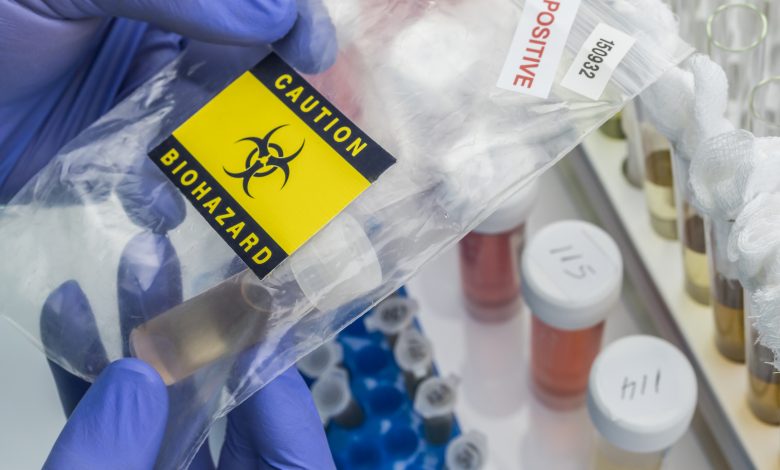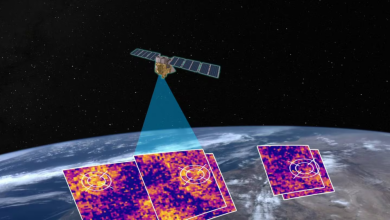
Vaccine rumours debunked: Microchips, ‘altered DNA’ and more
فضح شائعات اللقاح: الرقائق الدقيقة و “تعديل الحمض النووي” وغير ذلك
BBC
News of a vaccine which prevented 90% of people from getting Covid-19 in clinical trials led to a surge of anti-vaccine rumours on social media.
We’ve looked into some of the most widely shared false claims: about alleged plots to put microchips into people, the supposed re-engineering of our genetic code, and about safety.
Bill Gates and microchip claims
Bill Gates was trending on Twitter this week following the vaccine announcement.
The billionaire founder of Microsoft has been the subject of many false rumours during the pandemic.
He’s been targeted because of his philanthropic work in public health and vaccine development.
One of the most shared claims this week – one that has been circulating since early this year – is that the coronavirus pandemic is a cover for a plan to implant tiny trackable microchips in people and that Mr Gates is behind it all.
There is no evidence to support these claims and the Bill and Melinda Gates Foundation has told the BBC they’re entirely false.
Despite the lack of evidence, in May a YouGov poll of 1,640 people suggested 28% of Americans believed Mr Gates wanted to use vaccines to implant microchips in people – with the figure rising to 44% among Republicans.
‘Altered DNA’ claims
A White House correspondent for a pro-Trump website, Newsmax, told her 264,000 followers on Twitter to “beware” the Pfizer/BioNTech vaccine. Emerald Robinson claimed in the Tweet: “It tampers with your DNA.”
The fear that a vaccine will somehow change your DNA is another one we’ve seen aired regularly on Facebook posts.
The BBC asked three independent scientists about this. They said that the coronavirus vaccine would not alter human DNA.
It appears the people spreading such claims have a fundamental misunderstanding of genetics.
The vaccine contains a fragment of the virus’s genetic material – or RNA.
“Injecting RNA into a person doesn’t do anything to the DNA of a human cell,” said Prof Jeffrey Almond of Oxford University.
Pfizer spokesperson Andrew Widger said the company’s vaccine “does not alter the DNA sequence of a human body. It only presents the body with the instructions to build immunity”.
This isn’t the first time we’ve looked into claims that a coronavirus vaccine will alter DNA. We investigated a popular video spreading the theory back in May.
Part of the misunderstanding seems to stem from the type of vaccine being developed. The Pfizer/BioNTech vaccine uses messenger RNA, or “mRNA”, technology.
It works by giving the body instructions to produce a protein which is present on the surface of the coronavirus.
The immune system then learns to recognise and produce antibodies against the protein.
Ms Robinson’s tweet included the assertion that mRNA vaccine technology “has never been tested or approved before”.
It is true that no mRNA vaccine has been approved before, but multiple studies of mRNA vaccines in humans have taken place over the last few years.
Prof Almond says that the Pfizer/BioNTech vaccine is the first to show the efficacy that would be needed in order to be considered for licensing.
Just because it’s a new technology, he says, “it doesn’t mean we should be afraid of it”.
New vaccines undergo rigorous safety checks before they can be recommended for widespread use.
In Phase 1 and Phase 2 clinical trials, vaccines are tested in small numbers of volunteers to check they are safe and to determine the right dose. In Phase 3 trials they are tested in thousands of people to see how effective they are. The group who received the vaccine and a control group who have received a placebo are closely monitored for any adverse reactions – side-effects. Safety monitoring continues even after a vaccine is licensed.
Claire Wardle, author of a recent report about vaccine myths on social media, says there is a “data deficit” around topics like mRNA technology – a situation where there is high demand for information, but credible information is in low supply.
“This leaves people vulnerable to misinformation, which rushes in to fill the gap,” says Ms Wardle, executive director of anti-misinformation non-profit organisation First Draft.
“While credible information struggles to meet the demand, unreliable individual accounts and alternative news outlets are able to drive down confidence in vaccines,” she says.
Side-effects claims
Another claim in Ms Robinson’s tweet was among the most widely shared anti-vaccine themes this week.
She claimed 75% of vaccine trial volunteers had experienced side-effects. But Pfizer and BioNTech have reported no serious safety concerns in their trial.
Many vaccines do have side-effects. But the vast majority are not nearly as scary as anti-vaccine activists would have us believe.
“Like all vaccines, this vaccine can cause short-lived side-effects, including pain at the injection site, fever, muscle aches and pains, headache and fatigue,” said Dr Penny Ward, a visiting professor in pharmaceutical medicine at King’s College London.
Prof Ward pointed out that these kinds of side-effects are also experienced by a high number of people receiving the annual flu vaccination. The side-effects are usually mild, wear off after a couple of days at most, and can be alleviated with paracetamol or ibuprofen.
It’s unclear where Ms Robinson gets the 75% figure from, but it may have selectively been chosen from the rate of mild side-effects reported in one age group in an earlier phase of the trial.
Full data about side-effects has not yet been published for the most recent phase of the trial, but Pfizer has confirmed they observed no serious side-effects.
The BBC contacted Emerald Robinson for comment, and she stood by her claims.
Additional reporting by Kris Bramwell, Jack Goodman, Olga Robinson and Marianna Spring.
Source: bbc
بي بي سي
فجرت أنباء التوصل إلى لقاح أثبت في التجارب السريرية حمايته 90% من الناس من الإصابة بكوفيد-19 موجة من الشائعات المناهضة للقاح على وسائل التواصل الاجتماعي.
بحثنا في عدد من المزاعم الزائفة الأكثر تداولا، والتي تتعلق بمخططات مزعومة لزرع شرائح إلكترونية داخل أجسام الناس، وإعادة هندسة مزعومة لشفرتنا الجينية، وأخرى تخص سلامة اللقاح.
بيل غيتس ومزاعم الشرائح الإلكترونية
انتشر اسم بيل غيتس بصورة كبيرة على موقع تويتر هذا الأسبوع عقب الإعلان عن اللقاح.
وكان الملياردير ومؤسس شركة مايكروسوفت محور الكثير من المزاعم الزائفة منذ تفشي الوباء. إذ استهدف بسبب عمله الخيري في مجالات الصحة العامة ومساعي تطوير لقاح.
ومن بين أكثر المزاعم انتشاراً هذا الأسبوع، واحد كان قد تم تدواله في مطلع العام، مفاده أن وباء كورونا غطاء لخطة تهدف لزرع شرائح إلكترونية دقيقة يمكن تتبعها داخل أجسام الناس، وأن بيل غيتس يقف وراء كل ذلك.
ولا يوجد دليل يؤيد تلك المزاعم، كما أن مؤسسة بيل ومليندا غيتس أكدت لبي بي سي أنها عارية عن الصحة.
وعلى الرغم من عدم وجود دليل، كشف مسح أجرته مؤسسة يوغوف في مايو/ أيار وشمل 1640 شخصاً عن أن 28% من الأمريكيين يعتقدون أن غيتس يريد استخدام اللقاحات لزراعة شرائح إلكترونية داخل أجسام الناس، بينما ترتفع النسبة إلى 44% بين الجمهوريين.
مزاعم “تعديل الحمض النووي”
نصحت مراسلة موقع نيوماكس الموالي للرئيس الأمريكي دونالد ترامب متابعيها على تويتر وعددهم 264 ألفا بأن “يحذروا” اللقاح الذي تطوره شركتا فايزر وبيونتيك للأدوية.
وزعمت إميرالد روبينسون في تغريدتها أن اللقاح “يعبث في الحمض النووي”.
وكان الخوف بشأن تغيير الحمض النووي بشكل أو بآخر أمراً لاحظناه بشكل معتاد في منشورات على موقع فيسبوك.
وقد سألت بي بي سي ثلاثة علماء مستقلين، وقالوا إن لقاح فيروس كورونا لن يغير في الحمض النووي البشري.
ويبدو أن هؤلاء الذين يقومون بنشر هذه المزاعم لديهم سوء فهم أساسي لعلم الوراثة.
فاللقاح يحتوي على جزء من المادة الوراثية للفيروس RNA (الحمض النووي الريبي).
ويقول البروفيسور جيفري ألموند الأستاذ في جامعة أوكسفورد إن “حقن الشخص بالحمض النووي الريبي (للفيروس) لا يؤثر على الحمض النووي للخلية البشرية”.
كما ذكر المتحدث باسم شركة فايزر، أندرو ويدجر، على أن اللقاح الذي تنتجه الشركة “لا يغير تسلسل الحمض النووي لجسم الإنسان. إنه فقط يمد الجسم بتعليمات لبناء المناعة”.
ليست هذه المرة الأولى التي نبحث فيها في مزاعم بشأن تغيير لقاح فيروس كورونا للحمض النووي. وقد قمنا بالتحقيق في مقطع مصور شائع ينشر تلك النظرية في مايو/ أيار.
يبدو أن جزءاً من سوء الفهم ينبع من نوع اللقاح الذي يجري تطويره.
إذ أن لقاح فايزر/بيونتيك يستخدم تكنولوجيا messenger RNA (مرسال الحمض النووي الريبي). ويعمل من خلال إعطاء الجسم تعليمات لإنتاج بروتين مماثل لذلك الموجود على سطح فيروس كورونا.
عندئذ يتعلم جهاز المناعة التعرف عليه وينتج الأجسام المضادة له.
وتضمنت تغريدة روبينسون تأكيداً على أن اللقاح الذي يعتمد على تكنولوجيا مرسال حمض النووي ” لم يخضع للاختبار أو تتم الموافقة عليه من قبل”.
صحيح أنه لم تتم الموافقة من قبل على استخدام لقاح يعتمد على تكنولوجيا مرسال الحمض النووي، لكن دراسات عدة أجريت على البشر لهذه اللقاحات على مدى السنوات القليلة الماضية.
ويقول البروفيسور ألموند إن لقاح فايزر/ بيونتيك هو أول لقاح يثبت الفعالية المطلوبة للنظر في إمكانية الترخيص بانتاجه.
ويضيف “مجرد كونها تكنولوجيا جديدة لا يعني أنه يجب علينا أن نتخوف منها”.
وتخضع اللقاحات الجديدة لاختبارات سلامة مشددة قبل أن يوصى باستخدامها على نطاق واسع.
ففي المرحلتين الأولى والثانية من التجارب السريرية، يتم اختبار اللقاحات على عدد صغير من المتطوعين، للتحقق من سلامتها وتحديد الجرعة السليمة.
وفي المرحلة الثالثة يجرى اختبارها على آلاف الأشخاص للوقوف على قدر فعاليتها.
كما تجري عن كثب مراقبة المجموعة التي تلقت اللقاح والمجموعة التى تلقت لقاحاً وهميا، تحسباً لأي ردود فعل سلبية أو آثار جانبية. وتستمر عملية مراقبة السلامة حتى بعد حصول اللقاح على الترخيص.
وتقول كلير واردل -والتي أعدت تقريراً حديثاً عن أساطير اللقاحات على وسائل التواصل الاجتماعي- إن هناك “عجز بيانات” بخصوص موضوعات مثل تكنولوجيا مرسال الحمض النووي الريبي، ويحدث هذا حين يرتفع الطلب على المعلومات وينخفض قدر المعلومات ذات المصداقية.
وتضيف: “هذا يترك الناس عرضة للمعلومات المضللة التي تندفع لملء الفراغ”.
وتعمل كلير واردل مديرة تنفيذية لمؤسسة First Draft (المسودة الأولى) الخيرية لمناهضة المعلومات المضللة.
وتقول: “بينما تواجه المعلومات الموثوقة صعوبة في تلبية الطلب، تتمتع الحسابات الفردية ومنافذ الأخبار البديلة بالقدرة على خفض الثقة في اللقاحات”.
مزاعم الآثار الجانبية
تضمنت تغريدة روبينسون ادعاء آخر كان ضمن أكثر الموضوعات المناهضة للقاحات شيوعاً هذا الأسبوع.
حيث زعمت أن 75% من المتطوعين في تجربة اللقاح أصيبوا بأعراض جانبية. غير أن فايزر وبيونتيك لم تبلغا عن وجود مخاوف خطيرة تتعلق بالسلامة خلال التجربة.
لا شك أن هناك أثارا جانبية للعديد من اللقاحات، لكن غالبيتها ليست مخيفة بقدر ما يروج النشطاء المناهضون للقاحات.
وتقول الدكتورة بيني وارد أستاذة الطب الدوائي الزائرة في جماعة كينجز كوليدج بلندن “على غرار كل اللقاحات، يمكن لهذا اللقاح أن يسبب أعراضاً قصيرة المدى، مثل ألم في موضع الوخزة وارتفاع درجة الحرارة وآلام العضلات والصداع والشعور بالإرهاق”.
وأشارت البروفيسور وارد إلى أن هذه هي نفس الآثار الجانبية التي يصاب بها الكثير ممن يحصلون على لقاح الإنفلونزا السنوي.
وغالباً ما تكون هذه الآثار الجانبية خفيفة وتزول بعد يومين على الأكثر، ويمكن تخفيفها عن طريق تناول البارسيتامول أو الأيبوبروفين.
وليس واضحاً المصدر الذي استقت منه روبينسون نسبة الـ 75% هذه، لكنها ربما اختيرت بشكل انتقائي من معدل الآثار الجانبية الخفيفة لدى فئة عمرية معينة في مرحلة مبكرة من التجربة.
ولم تنشر بعد البيانات الكاملة بشأن الآثار الجانبية للمرحلة الأخيرة من التجربة، لكن فايزر أكدت أنها لم تسجل أي أعراض خطيرة.
واتصلت بي بي سي بإميرالد روبينسون للتعليق، وقد تمسكت بدورها بمزاعمها.
المصدر: bbc



